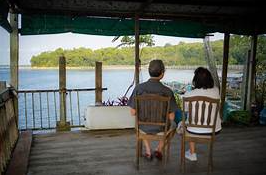The struggle to preserve a piece of Singapore’s maritime heritage amid modern challenges.
In August 2004, Timothy Ng and Maureen Ng took on the responsibility of managing a kelong, an offshore platform near Pulau Ubin. At the time, the couple, both 75 years old now, were looking for something to occupy their time after retirement when they saw an ad in The Straits Times offering the sale of a kelong. They purchased it for $61,200, investing an additional $92,000 to restore it to a fully operational state.
Timothy, a former Deputy Commissioner of the Inland Revenue of Singapore, and Maureen, a former principal at the National Junior College, saw it as a way to keep busy. “I always liked the sea,” Maureen remarked. “And I thought my husband needed a hobby to keep him alive after retirement.” Timothy adds, “I was about to retire, and my wife thought I should find something to keep me healthy.”
Kelongs, wooden platforms once common along Singapore’s coast, have greatly diminished in number over the decades. In the 1950s, Singapore’s coastal waters had about 300 kelongs, but by the 1960s, they began to disappear, with only four surviving today. These kelongs were used by fishermen to catch wild fish, and some owners lived there with their families.
Building a kelong involves constructing a base of interconnected wooden poles, which rise above the water and support a house. Although these structures appear fragile against the sea’s relentless forces, they are designed to endure by regularly replacing the wooden components. Timothy and Maureen’s kelong, built in 1972, has weathered the seas for over five decades.
The couple has poured significant resources into maintaining and modernizing their kelong, spending over $2 million since 2004. Despite the heavy financial strain, they feel it’s their responsibility to preserve the kelong, viewing it as part of Singapore’s heritage.
However, modern challenges have strained their ability to maintain it. The yield from their kelong’s nets has drastically decreased, with fish catches plummeting since a plankton bloom in 2015. What once yielded 200 kilograms of ikan bilis in a single net now offers only 30 percent of that.
As a result, the couple turned to commercial fish farming. Their floating fish farm sits next to the kelong, but even this venture has not been without its struggles. Timothy estimates they’ve lost about $30,000 trying to boost production. They’re now facing the added pressure of government regulations that require fish farms to meet higher production targets for continued lease renewals of sea space.
The Singapore Food Agency (SFA) has announced that soon, fish farms will be required to lease sea spaces, making it more difficult for small-scale kelongs like Timothy and Maureen’s to compete with larger commercial operations. Despite their best efforts, the couple fears they may not be able to meet these targets, further jeopardizing the future of their kelong.
Timothy and Maureen believe that kelongs should not just be seen as businesses but as living monuments to Singapore’s maritime past. The couple wishes to preserve the kelong for cultural purposes, hoping that it can serve as an educational tool for future generations. “We just want the kelong to continue standing in Singapore’s waters,” Timothy says, echoing the couple’s desire to safeguard this piece of history before it vanishes entirely.
As the sun sets on the kelong, the couple gazes out at the sea, uncertain about what the future holds but determined to fight for the preservation of this unique cultural heritage.


